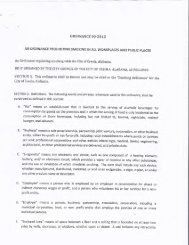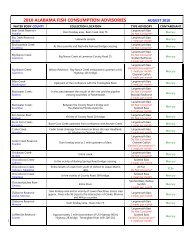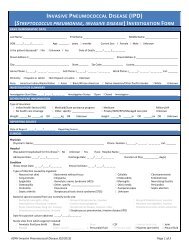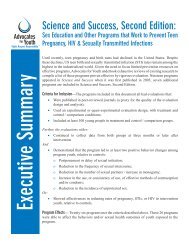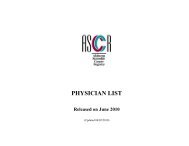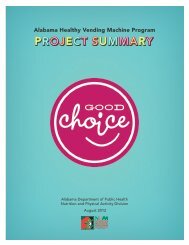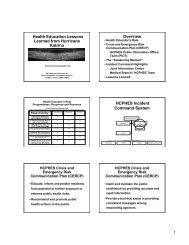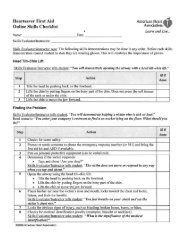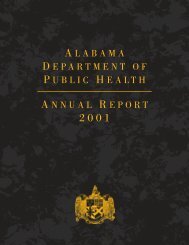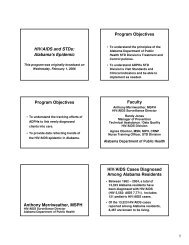2007 - Alabama Department of Public Health
2007 - Alabama Department of Public Health
2007 - Alabama Department of Public Health
You also want an ePaper? Increase the reach of your titles
YUMPU automatically turns print PDFs into web optimized ePapers that Google loves.
mission<br />
To serve the people <strong>of</strong> <strong>Alabama</strong> by assuring conditions in which they can be healthy.<br />
letter to the governor<br />
The Honorable Bob Riley<br />
Governor <strong>of</strong> <strong>Alabama</strong><br />
State Capitol<br />
Montgomery, <strong>Alabama</strong> 36130<br />
Dear Governor Riley:<br />
I am pleased to present the <strong>2007</strong> Annual Report <strong>of</strong> the<br />
<strong>Alabama</strong> <strong>Department</strong> <strong>of</strong> <strong>Public</strong> <strong>Health</strong>. This past year<br />
the <strong>Department</strong> provided opportunities for Alabamians<br />
to take steps toward a healthier lifestyle, created access to<br />
health care resources, and sustained programs that <strong>of</strong>fer<br />
valuable services to the public.<br />
Preventive health remains a primary goal <strong>of</strong> the<br />
<strong>Department</strong>. In an effort to fulfill this goal, the<br />
<strong>Department</strong> implemented and maintained programs<br />
that assist Alabamians in increasing their probability<br />
<strong>of</strong> avoiding serious health issues. One health issue that<br />
continues to affect the state’s population is obesity. At<br />
least two-thirds <strong>of</strong> Alabamians are overweight or obese,<br />
and these weight issues will cause premature death rates<br />
for decades to come.<br />
To address this issue, the <strong>Department</strong> helped launch<br />
the Scale Back <strong>Alabama</strong> program. This program<br />
encouraged teams <strong>of</strong> three to five people to lose weight<br />
and exercise. More than 5,000 teams participated in the<br />
contest, representing 46 <strong>of</strong> the state’s 67 counties, losing<br />
a grand total <strong>of</strong> 78,000 pounds.<br />
In an effort to assist <strong>Alabama</strong>’s future citizens, the<br />
Newborn Screening Program started several initiatives to<br />
provide even better protection. The program now screens<br />
newborns for 28 inherited disorders that could have<br />
serious long-term effects if left undetected or untreated.<br />
This expanded screening provides <strong>Alabama</strong> babies with<br />
a better start in life.<br />
A key issue for many in preventing death and disability<br />
is access to health care. Several <strong>Department</strong>al programs<br />
provided many Alabamians access to health care services<br />
that they would not otherwise be able to receive. The<br />
ALL Kids program, administered by the <strong>Department</strong>,<br />
marked a decade <strong>of</strong> providing health care coverage to<br />
children this past year. During this decade, ALL Kids<br />
provided comprehensive health care coverage to nearly<br />
186,000 children, making a pr<strong>of</strong>ound contribution toward<br />
reducing the number <strong>of</strong> uninsured children in the state.<br />
While the national rate for uninsured children is currently<br />
11.5 percent, <strong>Alabama</strong>’s rate has declined from 15 percent<br />
prior to ALL Kids to 7.2 percent at present, well under<br />
the national average. At the end <strong>of</strong> <strong>2007</strong>, a total <strong>of</strong> 69,076<br />
children were enrolled in ALL Kids, which represents a<br />
5.7 percent increase over 2006.<br />
In addition to ALL Kids, health care access was<br />
provided through the Plan First Program, which provided<br />
physical examinations, family planning services, and<br />
education to over 57,493 women ages 19-44 at or below the<br />
poverty level. The <strong>Alabama</strong> Breast and Cervical Cancer<br />
Program provided women ages 50 or older with pelvic<br />
exams, pap smears, breast exams, and mammograms,<br />
and diagnosed 175 women with breast or cervical cancer<br />
during <strong>2007</strong>. The Rural <strong>Health</strong> Section processed waivers<br />
2



